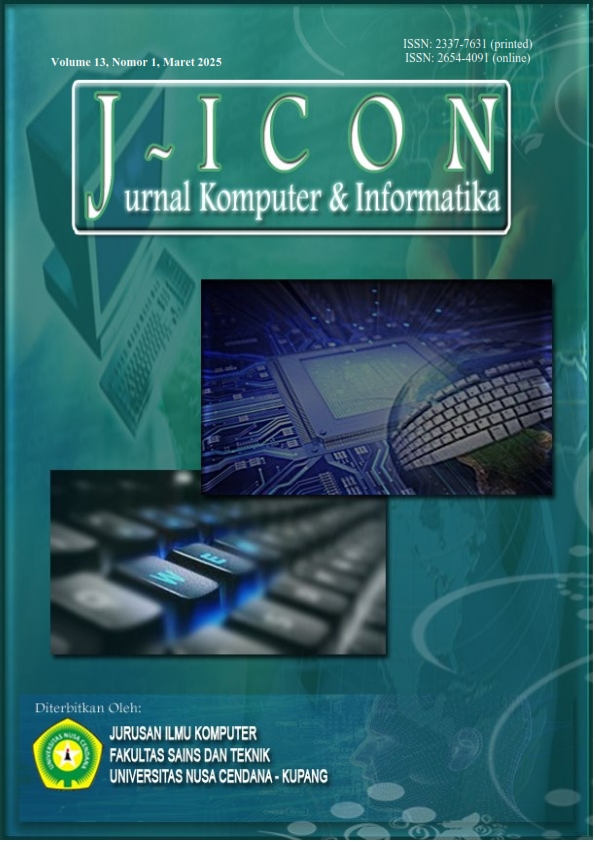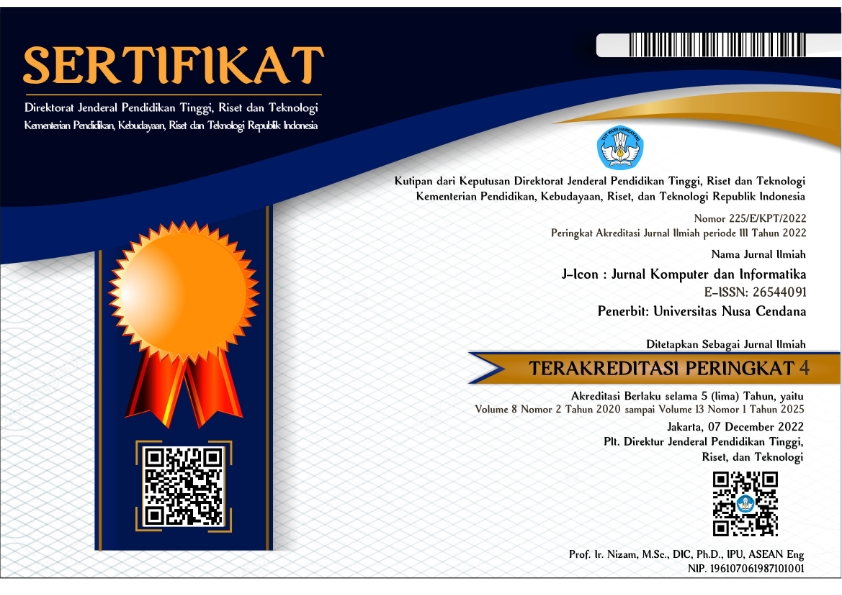WEBSITE DESIGN FOR NUTRITION STATUS CLASSIFICATION OF TODDLERS USING UI/X WITH K-MEDOIDS ALGORITHM
Abstract
Nutritional needs in Indonesia vary based on age, gender, physical activity, and an individual's health condition. According to Regulation of the Minister of Health of the Republic of Indonesia No. 28 of 2019, the Recommended Dietary Allowance (RDA) issued by the Ministry of Health provides guidelines on daily energy (calorie) requirements. For infants aged 0 to 12 months, the required intake is 550–725 kcal. The toddler phase (0–5 years old) is a golden period of growth, during which physical and brain development occurs rapidly. Malnutrition during this period can lead to growth disorders such as stunting, which has long-term effects on a child's health and intelligence. To determine a toddler's nutritional status, it is essential to classify their status based on weight and height ratio, commonly measured using Body Mass Index (BMI). BMI is used to determine whether a child's weight falls into the normal, underweight, or obese category. Therefore, regular monitoring is necessary to detect nutritional problems early, enabling proper intervention. This study aims to develop a website using the k-medoids algorithm to assess toddlers' nutritional status. The calculation process in this study, which involves 30 toddler data samples, determines the number of toddlers in each cluster: normal nutrition status, undernutrition, and obesity. The study also applies a Confusion Matrix to evaluate the clustering performance, including accuracy, precision, and recall. The evaluation results show that the k-medoids algorithm performs perfectly, achieving 100% accuracy for all clusters. This indicates that k-medoids successfully classifies the data into clusters without errors.
Downloads
References
[2] M. Muhammad, A. Mahmudi and K. Auliasari, “PERBANDINGAN METODE K-MEANS DAN K-MEDOIDS UNTUK KLASIFIKASI STATUS GIZI ANAK,” JATI (Jurnal Mahasiswa Teknik Informatika), pp. 2122-2129, 2023.
[3] M. S. Z. Harahap and M. , “Implementasi Data Mining Untuk Klustering Stunting Gizi Pada Balita Dipuskesmas Sigambal Meggunakan Metode K-Medoids Dan K-Means,” INFORMATIKA, vol. 12, no. 3, pp. 577-583, 2024.
[4] W. Wahyudi, A. C. P. Herlena and I. Yunianto, “Implementasi Data Mining Untuk Klasifikasi Stunting Gizi Pada Balita di Surabaya Menggunakan Metode K-Medoids,” JUPTI (Jurnal Publikasi Teknik Informatika), pp. 61-67, 2023.
[5] D. P. Sari, “Implementasi Algoritma K-Medoids dan Aplikasi RapidMiner dalam Pengelompokkan Kasus BALITA Stunting,” BRAHMANA: Jurnal Penerapan Kecerdasan Buatan, pp. 1-8, 2023.
[6] A. Nikmah, C. Nisa and M. Riefky, “Penerapan Algoritma K-Medoids untuk Pengelompokkan Provinsi di Indonesia Berdasarkan Status Gizi Anak Balita,” Emerging Statistics and Data Science Journal, pp. 516-524, 2025.
[7] F. M. Hidayat, T. Rohana, E. Nurlaelasari and A. F. N. Masruriyah, “KLASTERISASI KABUPATEN DAN KOTA DI JAWA BARAT DALAM KASUS GIZI BURUK MENGGUNAKAN ALGORITMA K-MEANS DAN K-MEDOIDS,” TEKINKOM, pp. 251-261, 2024.
[8] W. Aprilyani, K. E. Wahyudin, R. Hamonangan and R. Herdiana, “KLASTERISASI DATA PENJUALAN ALAT TRANSPORTASI DENGAN RAPIDMINER MENGGUNAKAN METODE K-MEDOID,” JATI (Jurnal Mahasiswa Teknik Informatika), pp. 1348-1353, 2024.
[9] H. Dewangga, K. and I. Y. Beti, “Penerapan Metode K-Medoid Dalam Pengelompokkan Data Pertanian Di Dinas Tanaman Pangan Hortikultura Dan Perkebunan Provinsi Bengkulu,” Jurnal Media Infotama, 2024.
[10] B. S. K. Aggraini and A. A. Dzikrullah, “mplementasi Analisis Clustering K-Medoidsdalam Pengelompokan Bayi Lahir, Gizi Buruk, danBBLR Berdasarkan Kecamatan di Kabupaten Sleman Tahun 2020,” Emerging Statistics and Data Science Journal, pp. 30-40, 2024.
[11] T. Ramayanti, E. Haerani and J. L. Oktavia, “Penerapan Algoritma K-Medoids Pada Clustering Penerima Bantuan Pangan Non Tunai (BPNT),” JURNAL MEDIA INFORMATIKA BUDIDARMA, pp. 1287-1296, 2023.
[12] S. Gultom, S. Sriadhi, M. Martiano and J. Simarmata, “Comparison analysis of K-Means and K-Medoid with Ecluidience Distance Algorithm, Chanberra Distance, and Chebyshev Distance for Big Data Clustering,” IOP Conference Series: Materials Science and Engineering, pp. 1-7, 2018.
[13] C. Komalasari, A. Faqih, F. Dikananda, M. Sulaeman and H. Susana, “ANALISIS SEGMENTASIPUSKESMAS DI KABUPATEN CIREBON MENGGUNAKAN ALGORITMA PARTITIONING AROUND MEDOIDBERDASARKAN INDIKATOR PENYEBAB STUNTING,” JATI (Jurnal Mahasiswa Teknik Informatika), pp. 3406-3413, 2023.
[14] P. A. Jusia, F. M. Irfan and K. , “Clustering Data Untuk Rekomendasi Penentuan Jurusan Perguruan Tinggi Menggunakan Metode K-Means,” Jurnal Komputer Dan Informatika, pp. 75-84, 2019.
Copyright (c) 2025 Ester Arisawati, Rinawati Rinawati, Erene Gernaria Sihombing, Frisma Handayanna, Linda Sari Dewi

This work is licensed under a Creative Commons Attribution 4.0 International License.
The author submitting the manuscript must understand and agree that if accepted for publication, authors retain copyright and grant the journal right of first publication with the work simultaneously licensed under a Creative Commons Attribution (CC-BY) 4.0 License that allows others to share the work with an acknowledgment of the work’s authorship and initial publication in this journal.
 Ester Arisawati(1)
Ester Arisawati(1)




